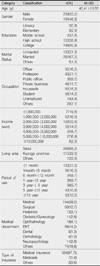Abstract
Purpose
The purpose of this study was to examine the causal relationships of perceived risk, satisfaction, switching cost and loyalty in outpatient health services.
Method
A survey using a structured questionnaire was conducted with 393 hospital outpatients. The analysis of data was done with both SPSS Win 17.0 for descriptive statistics and AMOS 18.0 for structural equation model.
Results
The causal model yielded Chi-square=31.44 (p=<.001), df=4, GFI=.98, AGFI=.87, CFI=.97, RMSR=.04, NFI=.96, IFI=.97 and showed relatively good fit indices. Perceived risk had a significant direct effect on customer satisfaction. Customer satisfaction, financial switching cost and relational switching cost had significant direct effects on customer loyalty. Perceived risk and customer satisfaction had significant indirect effects on customer loyalty.
Figures and Tables
References
1. Bollen KA. A new incremental fir index for general structural equation models. Sociol Methods Res. 1989. 17:303–316.
2. Byun KS, Cho YD, Shin MJ. The effect of perceived value, customer satisfaction, trust, switching costs on customer loyalty in fast food restaurant. Korean J Tourism Res. 2007. 22(2):37–58.
3. Burnham TA, Frels JK, Mahajan V. Consumer switching costs: a typology, antecedents, and consequences. J Acad Mark. 2003. 31(2):109–126.

4. Choi YJ, Yoo J. The causal relationship among relationship marketing implement factors, satisfaction, trust, switching costs, and customer loyalty in commercial sport centers. Korean J Sport Manage. 2007. 12(4):115–136.
5. Cronin JJ, Taylor SA. Measuring service quality: a reexamination and extension. J Mark. 1992. 56:55–58.

6. Dowling GR, Staelin R. A model of perceived risk and intended risk-handling activity. J Consum Res. 1994. 21(3):119–134.

7. Gremler DD. The effect of satisfaction, switching costs, and interpersonal bonds on service loyalty. 1995. Arizona: Arizona State University;Unpublished doctoral dissertation.
9. Jones MA, Mothersbaugh DL, Beatty SE. Switching barriers and repurchase intentions in services. J Retail. 2000. 76(2):259–274.

11. Jung Y. Developing customer switching costs model and measuring the effects of switching costs. 2007. Seoul: Yonsei University;Unpublished master's thesis.
12. Kim KS. Analysis structural equation modeling: amos 4. 2001. Seoul: SPSS Academy.
13. Kim SH, Oh SH. The determinants of repurchase intentions in the service industry: customer value, customer satisfaction, switching costs, and attractiveness of alternatives. Korean Mark Rev. 2002. 17(2):25–55.
14. Kim SH, Song MS. Analysis of the effects of perceived risk and customer satisfaction on hospital image and customer loyalty. Manag Rev. 2003. 12:31–56.
15. Kim YK, Jung KT, Ann YS, Lee SE, Jang YH, Han BR. The influence of dental service qualities on the patient satisfaction and royalty in dental clinics and hospitals. Korean J Hosp Manage. 2003. 8(3):49–71.
16. Kim HK. Study on the structural relationship of customers' satisfaction, value, loyalty, and image by utilizing the discordance of service quality and expectation. 2006. Seoul: Kyung Hee University;Unpublished doctoral dissertation.
17. Kim HR. A study on service quality, customer satisfaction, brand recognize and switching cost of customer loyalty in hotel restaurant. Korean J Tourism Res. 2008. 23(2):259–281.
18. Kim MJ, Lim YJ. The influence of the quality of service in the beauty industry on customer satisfaction, and the relationship between switching cost and customer loyalty. J Korean Soc Costumes. 2008. 58(9):99–113.
19. Ko YK, Kim BJ. The effects of switching cost perceived by patients and negative word of mouth on revisiting intention for hospital patients. J Korean Acad Nurs Adm. 2011. 17(1):5–13.

20. Lee SC, Lee HJ, Jung SH. Analysis of relating factors with customer loyalties in medical services. Korean J Health Policy Adm. 2005. 15(2):37–52.

21. Lee SH, Kim HM, Kim JH, Ha GY. How are consumers, service and marker factors related to consumer loyalty in medical service?: targeting the medical consumer in a city. J Prev Med Pub Health. 2008. 41(5):315–322.

22. Oliver RL. Satisfaction: a behavioral perspective on the consumer. 1997. New York: McGraw-Hill.
23. Prichard MP, Howard DR. The loyal traveler: examining a typology of service patronage. J Travel Res. 1997. Spring. 2–10.
24. Reichheld FF, Sasser WE. Zero defection: quality comes to service. Harv Bus Rev. 1990. 68(5):105–111.
25. Stone RN, Gronhaug K. Perceived risk: further considerations for the marketing discipline. Eur J Mark. 1993. 27(3):39–50.
26. Woodside AG, Frey LL, Daly RT. Linking service quality, customer satisfaction, and behavior intention. J Health Care Mark. 1989. 9(4):5–17.




 PDF
PDF ePub
ePub Citation
Citation Print
Print






 XML Download
XML Download